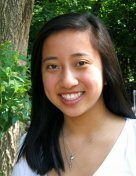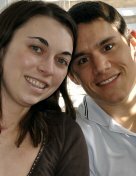The only visible sign of Amber Gray’s ordeal is the long slender scar that runs along her forearm. It is the area where a surgeon carefully removed her radial artery, which was needed to bypass a damaged artery in her brain.
Another scar, where Dr. Mario Zuccarello opened the skull to perform the bypass and clip a bleeding aneurysm, is barely visible, curving silently around her hairline on the left side of her head. A third scar, along her neck, fits neatly into the natural crease in her skin.
The other signs, too, have disappeared. Amber’s walk is brisk, her voice is strong, and her eyelid no longer droops. Ten weeks after suffering a life-threatening aneurysm rupture and stroke, the 19-year-old forward on the University of Tennessee women’s basketball team is well on her way to full recovery.
“I feel great,” said the former Lakota West High School All-American during her convalescence at home in suburban Cincinnati. “I’m getting back into my normal routine. I’m getting ready to get back to school as soon as possible.”
Amber, whose surgery took place at Cincinnati’s University Hospital, said she regards Dr. Zuccarello as “a hero who saved my life.” Dr. Zuccarello is a neurosurgeon with the Mayfield Clinic and the University of Cincinnati Neuroscience Institute.
Amber was in the recovery room at St. Mary’s Medical Center in Knoxville, Tennessee, following shoulder surgery for a torn rotator cuff on July 2, 2009, when a brain aneurysm, a balloon-like bulge on an artery in her brain, began to bleed. The rupture caused a bleeding, or hemorrhagic, stroke.
After the diagnosis of a stroke was made, Amber was flown to Cincinnati’s University Hospital, home of the UC Neuroscience Institute, for advanced neurosurgical care. Dr. Zuccarello, Director of the Institute’s Neurovascular Program and Interim Chairman of the UC Department of Neurosurgery, is a nationally recognized physician and researcher in the area of cerebrovascular disease. The cause of Amber’s stroke – the bleeding aneurysm – was discovered by Dr. Zuccarello and his cerebrovascular team.
“We went from celebrating the success of her shoulder surgery to finding out that she had had a stroke, then realizing that she had suffered a brain hemorrhage and an aneurysm,” said Amber’s mother, Tonya Carter.
Amber and her family had no inkling that she had an aneurysm prior to that day. No one in her family had ever suffered a ruptured aneurysm, so she was not a candidate for screening. “Among young people, only those with a family history of brain aneurysms should be considered for screening,” Dr. Zuccarello said.
Amber’s delicate and complex surgery took 12 ½ hours. Dr. Zuccarello first had to restore optimal blood flow to Amber’s brain by performing an arterial high-flow bypass between the external carotid artery (at the neck) and the large branch of a middle cerebral artery inside her skull. The procedure, also known as an extracranial-intracranial bypass, accomplishes for the brain what a coronary bypass accomplishes for the heart. Dr. Zuccarello used the radial artery from Amber’s arm to bypass the damaged cerebral artery. After a vascular surgeon “harvested” the radial artery, Dr. Zuccarello attached it to her carotid artery at the neck, threaded it under her skin and into her skull, and then attached it to a healthy artery. That mission accomplished, he then attached a clip to the aneurysm, effectively stopping the bleeding. “In this operation there are many surgical steps, which account for the length of surgery,” Dr. Zuccarello said.
Amber has few memories of her time in the Neuroscience Intensive Care Unit in Cincinnati.
“I remember going into my shoulder surgery in Knoxville,” she recalled. “And then I remember one specific day when I was at UC, and that’s because my best friend came to see me: Mark Brogden, who played football for Lakota West. And then my favorite teacher, Michelle Day, who was my English teacher at Lakota West, came to see me. I remember that. And honestly, I don’t remember too much of anything else, so it hasn’t hit me yet. I haven’t cried about it.”
Of course, Amber’s mother, who likened the whole experience to getting hit by a bus, has vivid memories and still gets teary when recounting them. “When Amber was still at St. St. Mary’s and in intensive care and on oxygen, the entire basketball team made a horseshoe around her bed, and they all held hands and prayed for her,” Tonya said. Amber’s teammates, along with the Tennessee coaching staff and administration, continued to support her in Cincinnati. Several of them flew in, including Pat Summitt, the legendary coach of the Lady Vols.
Tonya said she is forever grateful to Dr. Zuccarello and the entire surgical and neurocritical care team at the UC Neuroscience Institute.
“From the very first consultation with Dr. Zuccarello, the care they took in determining and explaining what medical procedure she would undergo was impressive,” Tonya said. “I also want to mention the care she received in total. All of the nurses, even the physical therapists at UC -- whom Amber doesn’t remember – were so helpful. There was a time when she couldn’t walk at all, and they were so encouraging, so supportive, getting her up, getting her moving.”
Tonya also thanks Dr. Zuccarello for his cosmetic approach, which left the attractive, 19-year-old Amber virtually unscarred. “He took so much care in doing the incision behind the hairline,” Tonya said. “He took off only a very small strip of hair, only what they truly needed. He respected how she would look physically after the procedure.”
Amber left University Hospital after three weeks and continued her intensive rehabilitation for another three weeks at Cincinnati’s Drake Center. As she left Drake two weeks ahead of schedule, doctors attributed her rapid and impressive recovery to state-of-the-art care and rehabilitation, her youth and athleticism, and her determination to regain her health. Mark Goddard, M.D., Director of Physical Medicine and Rehabilitation at Drake Center and a PM&R physician at the UC Neuroscience Institute, described her recovery as “meteoric.”
Ten weeks after her stroke, Amber had completely recovered mentally and was focused on rehabilitating her shoulder and spending time with her family before heading back to school. She plans to return to Knoxville in mid-October and to resume her classes in sports management and communications in January 2010. Once she begins playing basketball again, she may need to wear special gear to protect the left side of her head, where the artery was replaced.
Meanwhile, in the realm of communications, she has chosen to share her story in an effort to give hope to others who are facing recovery and rehabilitation following a neurological event. “There are a lot of people who have brain aneurysms and don’t stay positive,” Amber said. “So I think my story is to encourage people to make sure they do stay positive. I’m able to return to a sport that I love and play basketball again, and that’s very important to me. And seeing my friends and family support me means a lot. I want others to be able to move forward also.
“Dr. Zuccarello is a hero to me now. Without God, him, my friends, and my family, there’s no way I would have gotten through this. So as much as I’m promoting staying positive, I know that with God you can get through everything. I think my story truly promotes that.”
 RSS Feed
RSS Feed

